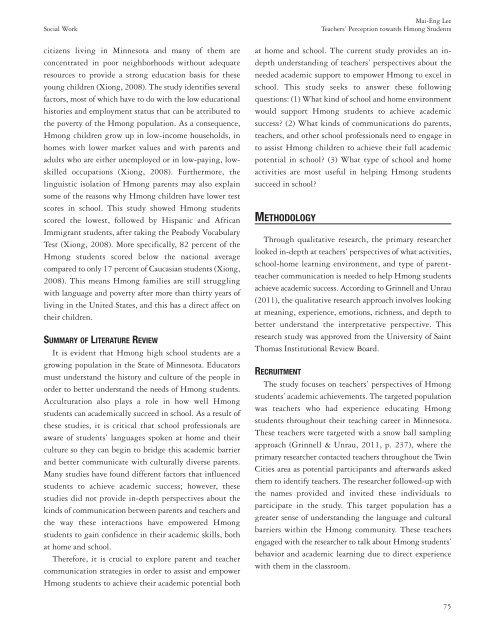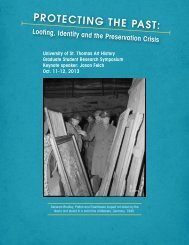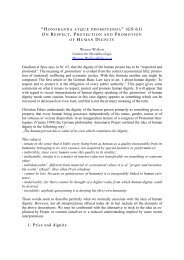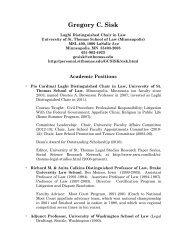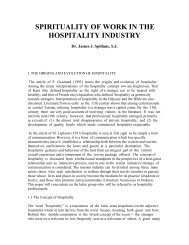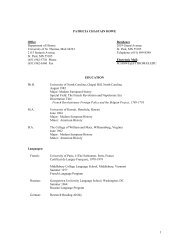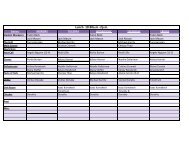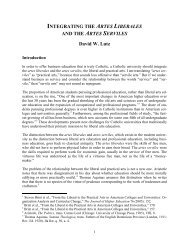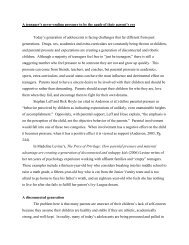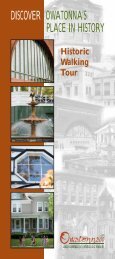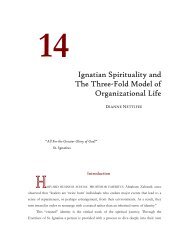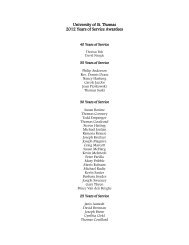dr. ronald e. mcnair acknowledgements - University of St. Thomas
dr. ronald e. mcnair acknowledgements - University of St. Thomas
dr. ronald e. mcnair acknowledgements - University of St. Thomas
You also want an ePaper? Increase the reach of your titles
YUMPU automatically turns print PDFs into web optimized ePapers that Google loves.
Mai-Eng Lee<br />
Social Work Teachers’ Perception towards Hmong <strong>St</strong>udents<br />
citizens living in Minnesota and many <strong>of</strong> them are<br />
concentrated in poor neighborhoods without adequate<br />
resources to provide a strong education basis for these<br />
young chil<strong>dr</strong>en (Xiong, 2008). The study identifies several<br />
factors, most <strong>of</strong> which have to do with the low educational<br />
histories and employment status that can be attributed to<br />
the poverty <strong>of</strong> the Hmong population. As a consequence,<br />
Hmong chil<strong>dr</strong>en grow up in low-income households, in<br />
homes with lower market values and with parents and<br />
adults who are either unemployed or in low-paying, lowskilled<br />
occupations (Xiong, 2008). Furthermore, the<br />
linguistic isolation <strong>of</strong> Hmong parents may also explain<br />
some <strong>of</strong> the reasons why Hmong chil<strong>dr</strong>en have lower test<br />
scores in school. This study showed Hmong students<br />
scored the lowest, followed by Hispanic and African<br />
Immigrant students, after taking the Peabody Vocabulary<br />
Test (Xiong, 2008). More specifically, 82 percent <strong>of</strong> the<br />
Hmong students scored below the national average<br />
compared to only 17 percent <strong>of</strong> Caucasian students (Xiong,<br />
2008). This means Hmong families are still struggling<br />
with language and poverty after more than thirty years <strong>of</strong><br />
living in the United <strong>St</strong>ates, and this has a direct affect on<br />
their chil<strong>dr</strong>en.<br />
SUMMARY OF LITERATURE REVIEW<br />
It is evident that Hmong high school students are a<br />
growing population in the <strong>St</strong>ate <strong>of</strong> Minnesota. Educators<br />
must understand the history and culture <strong>of</strong> the people in<br />
order to better understand the needs <strong>of</strong> Hmong students.<br />
Acculturation also plays a role in how well Hmong<br />
students can academically succeed in school. As a result <strong>of</strong><br />
these studies, it is critical that school pr<strong>of</strong>essionals are<br />
aware <strong>of</strong> students’ languages spoken at home and their<br />
culture so they can begin to bridge this academic barrier<br />
and better communicate with culturally diverse parents.<br />
Many studies have found different factors that influenced<br />
students to achieve academic success; however, these<br />
studies did not provide in-depth perspectives about the<br />
kinds <strong>of</strong> communication between parents and teachers and<br />
the way these interactions have empowered Hmong<br />
students to gain confidence in their academic skills, both<br />
at home and school.<br />
Therefore, it is crucial to explore parent and teacher<br />
communication strategies in order to assist and empower<br />
Hmong students to achieve their academic potential both<br />
at home and school. The current study provides an indepth<br />
understanding <strong>of</strong> teachers’ perspectives about the<br />
needed academic support to empower Hmong to excel in<br />
school. This study seeks to answer these following<br />
questions: (1) What kind <strong>of</strong> school and home environment<br />
would support Hmong students to achieve academic<br />
success? (2) What kinds <strong>of</strong> communications do parents,<br />
teachers, and other school pr<strong>of</strong>essionals need to engage in<br />
to assist Hmong chil<strong>dr</strong>en to achieve their full academic<br />
potential in school? (3) What type <strong>of</strong> school and home<br />
activities are most useful in helping Hmong students<br />
succeed in school?<br />
METHODOLOGY<br />
Through qualitative research, the primary researcher<br />
looked in-depth at teachers’ perspectives <strong>of</strong> what activities,<br />
school-home learning environment, and type <strong>of</strong> parentteacher<br />
communication is needed to help Hmong students<br />
achieve academic success. According to Grinnell and Unrau<br />
(2011), the qualitative research approach involves looking<br />
at meaning, experience, emotions, richness, and depth to<br />
better understand the interpretative perspective. This<br />
research study was approved from the <strong>University</strong> <strong>of</strong> Saint<br />
<strong>Thomas</strong> Institutional Review Board.<br />
RECRUITMENT<br />
The study focuses on teachers’ perspectives <strong>of</strong> Hmong<br />
students’ academic achievements. The targeted population<br />
was teachers who had experience educating Hmong<br />
students throughout their teaching career in Minnesota.<br />
These teachers were targeted with a snow ball sampling<br />
approach (Grinnell & Unrau, 2011, p. 237), where the<br />
primary researcher contacted teachers throughout the Twin<br />
Cities area as potential participants and afterwards asked<br />
them to identify teachers. The researcher followed-up with<br />
the names provided and invited these individuals to<br />
participate in the study. This target population has a<br />
greater sense <strong>of</strong> understanding the language and cultural<br />
barriers within the Hmong community. These teachers<br />
engaged with the researcher to talk about Hmong students’<br />
behavior and academic learning due to direct experience<br />
with them in the classroom.<br />
75


